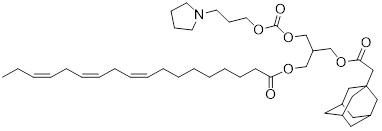Lysophosphatidic Acid (LPA) is a small lysophospholipid involved in diverse cellular processes such as cell proliferation, chemotaxis, platelet aggregation, wound healing, angiogenesis, tumor invasion, and smooth muscle contraction. LPA binds to several G-coupled protein receptors to initiate its biological functions. In cancer, LPA primarily promotes cell survival, migration and invasion. May contain up to 5-10% of the 2-acyl isomer due to acyl transfer.
Product Number: L-0204
Arachidonoyl LPA, 20:4 LPA
Lysophosphatidic Acid (LPA) is a small lysophospholipid involved in diverse cellular processes such as cell proliferation, chemotaxis, platelet aggregation, wound healing, angiogenesis, tumor invasion, and smooth muscle contraction. [Read More...]




